In the wonderful world of bulldogs, diversity flourishes in a palette of colors as vibrant as the personalities that they embody. From the classic English bulldog with its iconic wrinkled face and determined stance to the playful French bulldog with its bat-like ears and compact charm, these breeds share more than just their bulldog lineage. From majestic brindles to pristine whites, each bulldog variant showcases a spectrum of hues. Amidst this kaleidoscope of colors, one constant remains: the bulldog spirit, forever devoted and delightfully captivating. Continue reading to discover bulldog colors from the rarest to the most common.
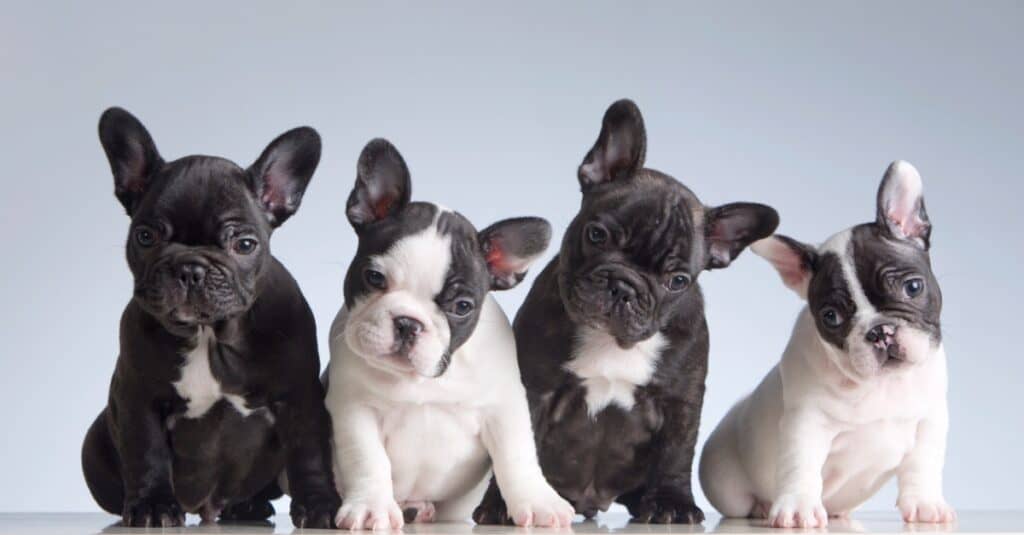
French bulldogs have bat-like ears and compact charm.
©iStock.com/Celiaaa
Bulldog Colors: The Possibilities
Coat colors in bulldogs are categorized as standard and non-standard. Standard colors adhere to breed norms and are widely accepted within breed standards. Conversely, non-standard colors arise from genetic variations, deviating from established norms. While these non-standard hues appear unique, they can be associated with health concerns due to the underlying genetic factors.
Individual bulldog breeds exhibit a diverse range of coat colors. Each breed has distinct most common and rarest color variations. English Bulldogs often sport fawn or brindle coats as their most prevalent hues, while rare colors like blue or black tri-color are less common. Similarly, French Bulldogs are frequently seen in fawn, cream, or brindle coats, with less frequent colors of solid black or blue. The spectrum of shades and combinations in bulldog coloration includes:
- Solid Colors: Bulldogs can come in solid colors like white, fawn (light tan), and black.
- Piebald: Bulldogs with large areas of white and patches of another color.
- Tricolor: Bulldogs with three distinct colors, often with a base color of white.
- Fawn and White: A common combination with a light tan base color and white markings.
- Black and White: Bulldogs with a black base color and white markings.
- Red and White: Bulldogs with a reddish base color and white markings.
- Blue: A dilute of black, giving a bluish-gray appearance.
- Lilac: A diluted chocolate color resulting in a pale, grayish hue.
- Merle: Bulldogs with a mottled coat featuring dark patches on a lighter background.
- Sable: Bulldogs with a mix of black-tipped hairs on a lighter background.
- Brindle: a light base coat streaked with multiple other colors.
- Reverse Brindle: Bulldogs with a darker base coat and lighter brindle stripes.
- Brindle and White: Brindle striping combined with white markings.
So which colors are most and least common in individual breeds? Let’s find out!
English Bulldog
Rarest: Merle Most common: Brindle
The English Bulldog is a medium-sized, muscular dog breed with a distinct wrinkled face, pushed-in nose, and loose, saggy skin. They have a stocky build and a distinctive waddle when they walk. They are now known for their calm and friendly temperament. Despite their historical association with aggression, modern English Bulldogs are gentle, loyal, and often enjoy a relaxed indoor lifestyle.
The breed standards for English Bulldogs are fawn, red, white, and brindle. Examples of non-standard colors in English bulldogs are merle, blue, and black. Blue English bulldogs are controversial due to potential skin and health issues associated with the color gene.
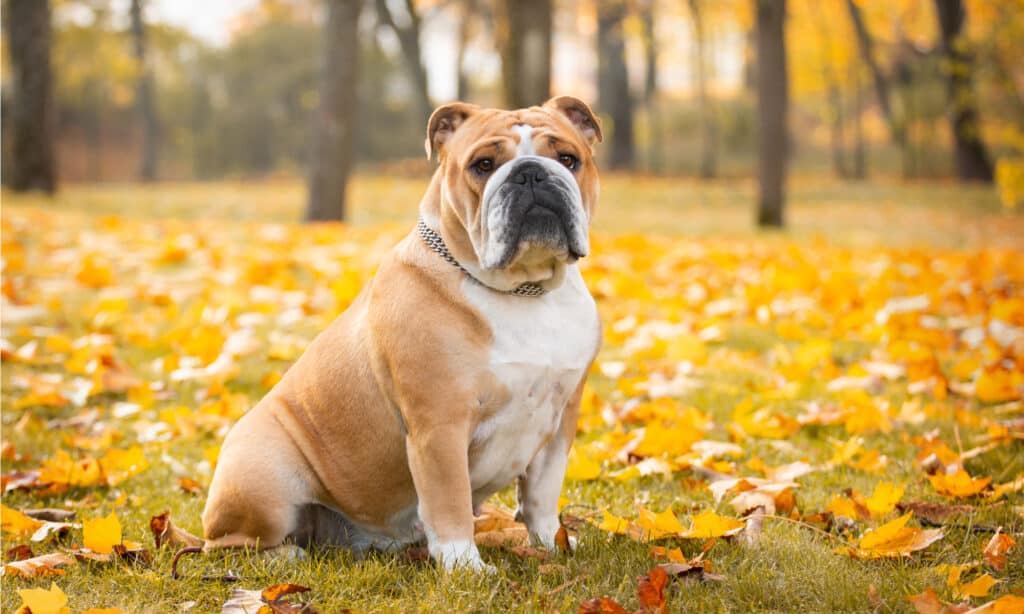
English bulldogs have a stocky build and a distinctive waddle when they walk.
©Vera Reva/Shutterstock.com
French Bulldog
Rarest: Blue Most Common: Brindle
The French Bulldog is a small, compact dog breed with a muscular body, large bat-like ears, and a short snub nose. Frenchies have a friendly and playful personality, making them great companions. French Bulldogs are known for their affectionate nature and adapt well to indoor living. Though Frenchies come in a wide variety of colors, the American Kennel Club only recognizes 9 colors and 5 color combinations. The color requirements for French bulldogs have been in place since 1911. Acceptable colors are all brindle, fawn, white, brindle, and white. Some rare colors are associated with health issues in French bulldogs. White Frenchies are likely to be deaf, for example. The most common coat color for French bulldogs is brindle. Because blue is the least common color of these adorable little pups, you’re likely to pay an uncommon sum for one!
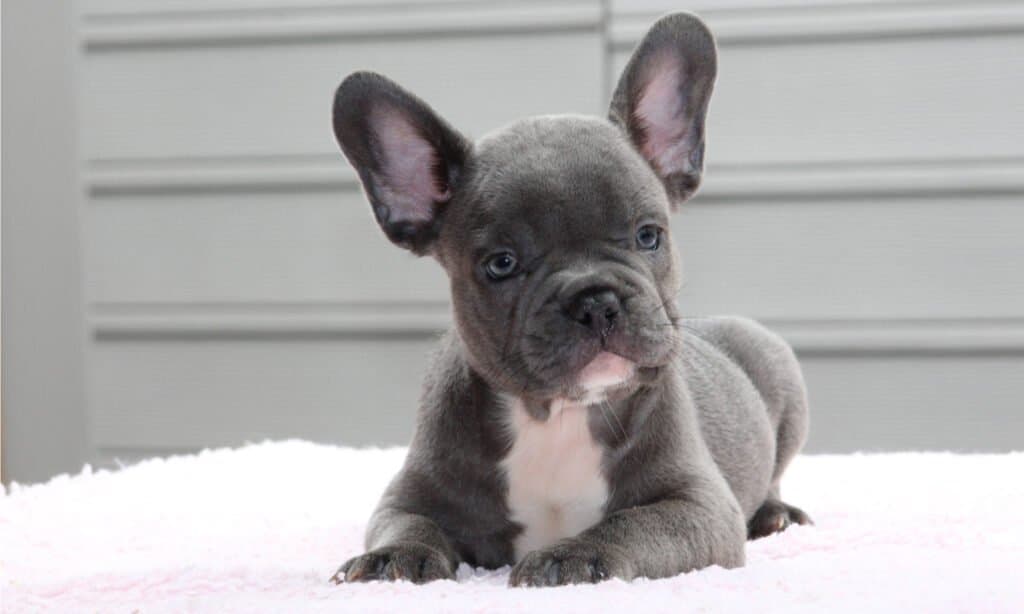
Blue (pictured) is the rarest color for French bulldogs
©Juan Carlos Soto Pendas/Shutterstock.com
American Bulldog
Rarest: Lilac Most Common: Piebald
The American bulldog is a hardy and athletic breed with a powerful build and a distinctive appearance. They exhibit strength and determination, reflecting their historical use as working dogs on farms. With a loyal and protective nature, they make excellent family companions and guardians. Their muscular physique and alert expression showcase their readiness for activity and their natural inclination to engage in physical tasks. Standards for American bulldogs are a bit more relaxed than in some other breeds. The coat must contain a minimum of 10% white or white markings. Except for solid black, solid blue, merle, tri-color, and fawn, all other coat color patterns are considered standard. Lilac is the least common color of American bulldogs.
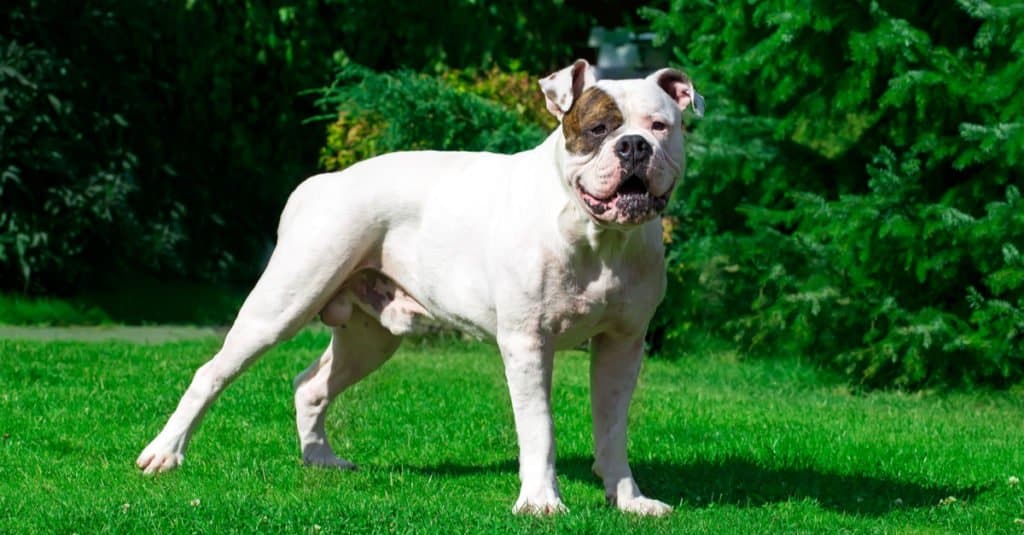
American bulldogs are most likely to have a white coat with patches of brindle, red, or fawn.
©Little Moon/Shutterstock.com
Australian Bulldog
Rarest: Blue Most Common: Piebald
The Australian bulldog is a breed that was developed in Australia, known for its friendly demeanor and adaptability. Bred as a family companion and as a working dog, Australian bulldogs have a gentle and affectionate nature, making them great with children and other pets. Their coat is short and smooth, displaying various colors and patterns. Aussies come in over 20 color combinations! Shades of apricot, fawn, orange, mahogany, red, and white are common. Aussies also come in at least 5 shades of brindle including black brindle, fawn brindle, mahogany brindle, red brindle, and silver brindle. Aussies are most commonly piebald, however, with patches of white and brown, fawn, or brindle. The rarest of the rare, blue Australian bulldogs are practically non-existent.

Australian Bulldogs have a gentle and affectionate nature, making them great with children and other pets.
©JCM Photos/Shutterstock.com
Spanish Bulldog
Rarest: Black Most Common: Brindle
The Spanish Bulldog, also known as the Alano Español, is a breed with a rich history rooted in Spain. Originally bred for hunting, herding, and guarding, they are masters of versatility and determination. Their distinctive appearance includes a strong head and a well-defined build, which highlights their functional attributes. Recognized coat colors include fawn and brindle. The brindle may be black, fawn, gray, silver, brown, liver, Isabella, gold, or tiger. Non-standard colors are solid black, and white when it accounts for more than 20% of the coat. It is no surprise that brindle is the most common color for Spanish bulldogs. The rarest color of Alano Español is solid black.
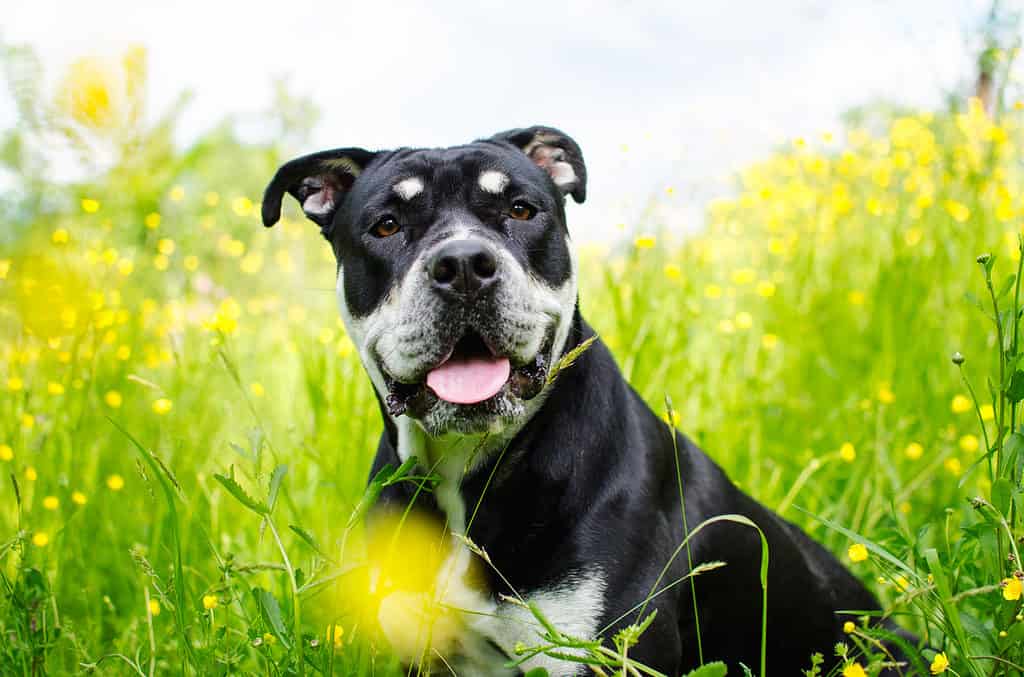
Australian bulldogs have a strong head and a well-defined build,
©PH_Anna/Shutterstock.com
Victorian Bulldog
Rarest: Black Most Common: Bindle
The Victorian Bulldog is a breed developed to resemble the Bulldogs of the Victorian era, known for their distinctive appearance and gentle temperament. They have a muscular and medium-sized build, often displaying loose skin and a stocky body. Bred for companionship, Victorian Bulldogs are characterized by their friendly and sociable nature, making them great family pets. While they may retain some of the traditional Bulldog traits, they are generally bred to have fewer health issues and more manageable characteristics compared to some modern Bulldogs. Because they are a relatively new breed (1980s) they are not recognized by any official kennel club. Victorian bulldogs are commonly brindle, fawn, red, and white. Black is absent in the breed. This is attributed to selective breeding practices.
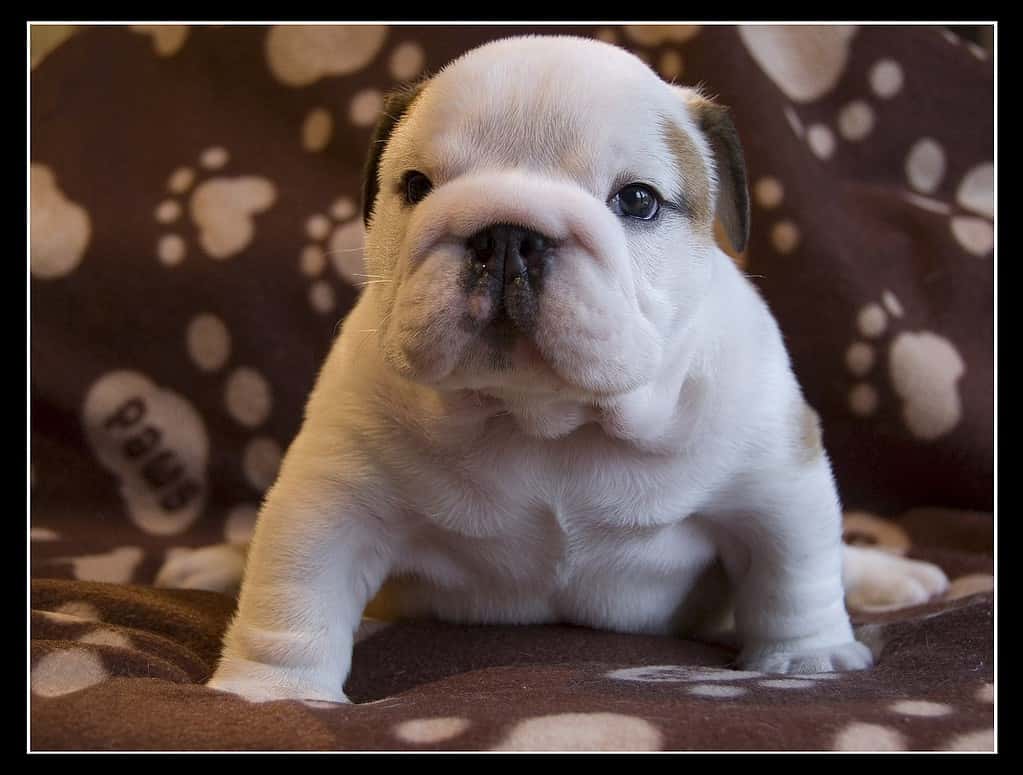
Victorian Bulldogs are characterized by their friendly and sociable nature, making them great family pets.
©Clare Black from Morley, UK, CC BY 2.0 – License
Miniature Bulldog
Rarest: Merle Most Common: Black and fawn
A Miniature Bulldog is an English bulldog/pug mix. It is a smaller version of the classic bulldog breed, featuring the same distinctive traits in a more compact size. With a stocky build, wrinkled face, and pushed-in nose, they retain the recognizable bulldog appearance. Despite their smaller stature, they maintain the friendly and gentle temperament associated with bulldogs. Miniature bulldogs are well-suited for indoor living and make affectionate companions.
Miniature bulldogs are not recognized by any official clubs, so they have not acquired standards. However, these adorable little doggos are commonly black, fawn, red, silver, white, or brindle. They are likely to have a combination of two colors, the most common being black and fawn. Merle is considered the rarest coloring.

Alapaha Blue Blood Bulldog
Rarest: White Most Common: Piebald
The Alapaha Blue Blood bulldog, originating in Rebecca, Georgia, is a rare and distinctive breed known for its protective nature and loyalty. These dogs were historically utilized for farm work and guarding, which contributes to their vigilant and watchful demeanor. Despite their imposing appearance, Alapaha Blue Blood bulldogs form strong bonds with their families. Their striking coat often displays a range of colors and patterns. The preferred coloring for Alapahas is at least 50% white with black, fawn, red, or brindle markings. Pure white Alapahas are rare and often deaf, blind, or suffer from skin conditions.
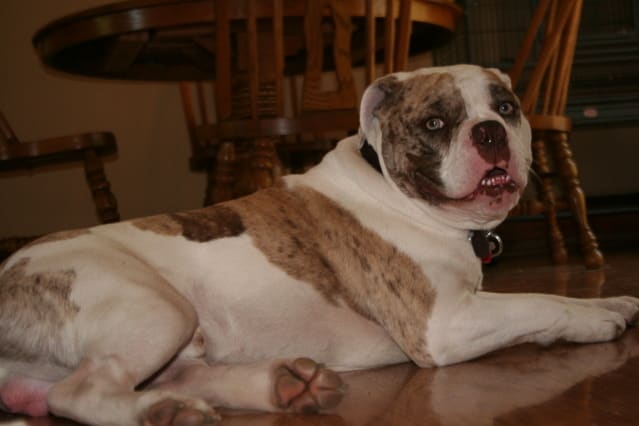
Alapaha Blue Blood bulldogs often display a range of colors and patterns.
©AlapahaOtis / CC0 1.0 – License
Olde English Bulldogge
Rarest: Lilac Most Common: Brindle
The Olde English Bulldogge is a breed that harkens back to the historical working bulldogs of the past. They possess a sturdy and functional build. Despite their muscular appearance, Olde English Bulldogges have a friendly and affectionate disposition, making them devoted companions. Olde English Bulldogges come in a variety of colors and color combinations. Standard colors include brindle and solid colors with or without the presence of white. Though lilac is the least common color in Olde English Bulldogges, blue, blue-tri, chocolate, chocolate-tri, and black-tri are also rare. Albinism, solid blue, and black with mahogany, rust, or tan patches are considered non-standard colors.
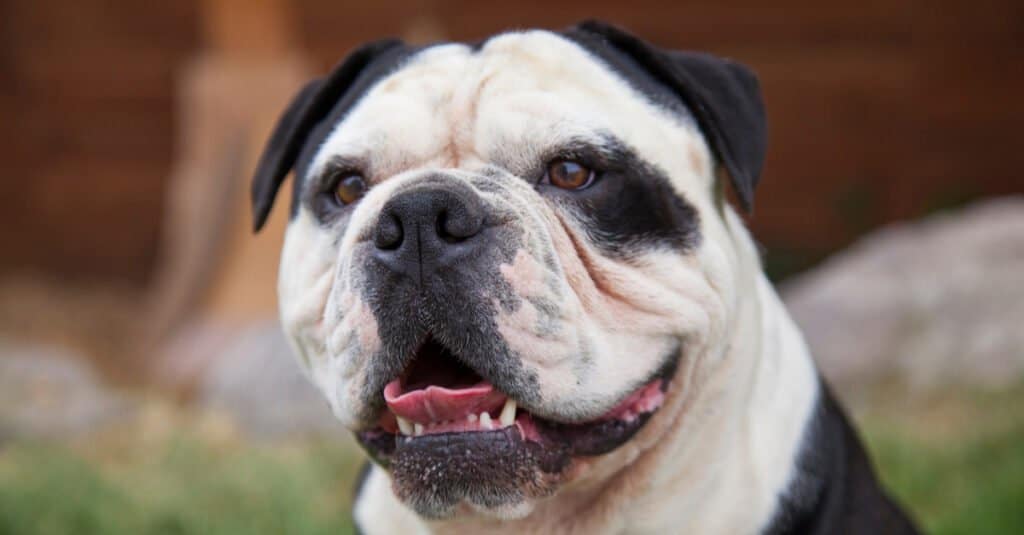
Olde English Bulldogge colors include brindle and solid colors with or without the presence of white.
©Jaden Cardona Photography/Shutterstock.com
Campeiro Bulldog
Rarest: Blue Most Common: Piebald
The Campeiro Bulldog, also known as the Brazilian Bulldog or Campeiro Bulldogge, is a breed hailing from Brazil. With a loyal and protective nature, they excel as guard dogs and are dedicated to their families. Their coat is typically short and smooth, and they come in a variety of colors. Campeiros are generally piebald. Traditionally they are brown, fawn, or brindle with white patches. The rarest color is blue. This coloration only appeared after an Old English Bulldogge was added to the mix.

The Campeiro bulldog hails from Brazil.
©André Lage Freitas, CC BY-SA 3.0 – License
Continental Bulldog
Rarest: Blue Most Common: Fawn
The Continental bulldog, also referred to as the Continental Bulldogge, is a breed known for its gentle disposition. They have a friendly and adaptable personality, making them great family companions. Their coat can be short and smooth, showcasing various colors and patterns. Acceptable colors in the breed are brindle of black, fawn, gray, or red; either solid or pied (with white). Solid black, fawn, red, or white are also recognized. Blue is a rare and non-standard color for the breed.
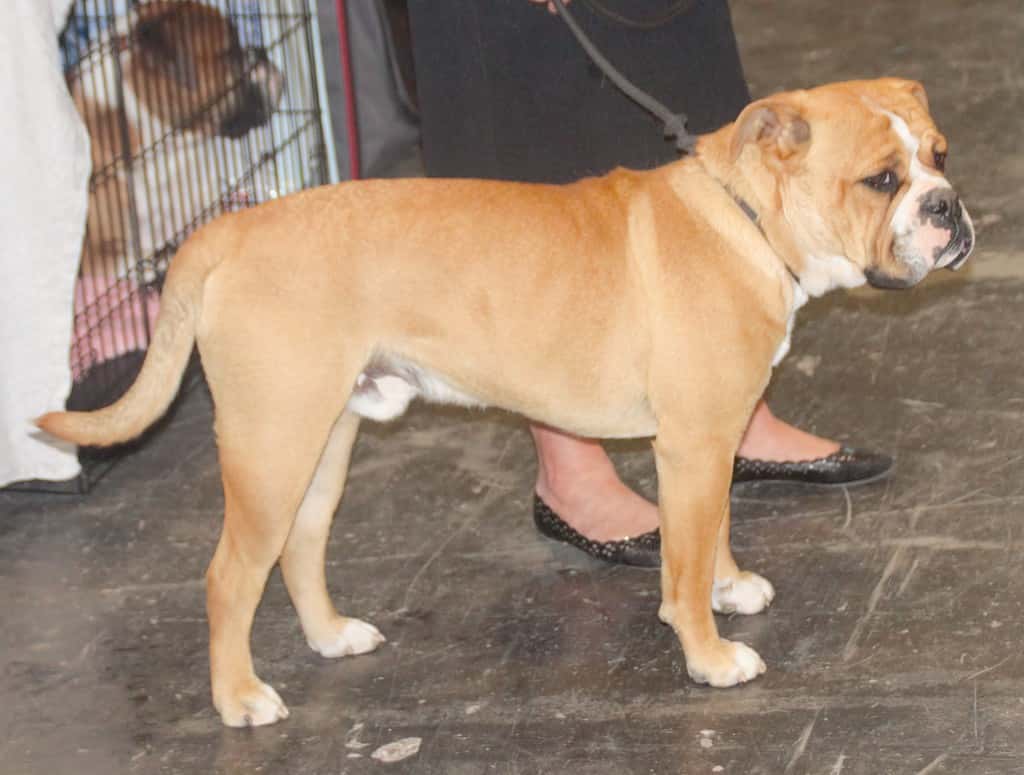
Continental bulldogs are most often have fawn coats.
©Canarian, CC BY-SA 4.0 – License
The photo featured at the top of this post is © iStock.com/yhelfman
Ready to discover the top 10 cutest dog breeds in the entire world?
How about the fastest dogs, the largest dogs and those that are -- quite frankly -- just the kindest dogs on the planet? Each day, AZ Animals sends out lists just like this to our thousands of email subscribers. And the best part? It's FREE. Join today by entering your email below.
Thank you for reading! Have some feedback for us? Contact the AZ Animals editorial team.






